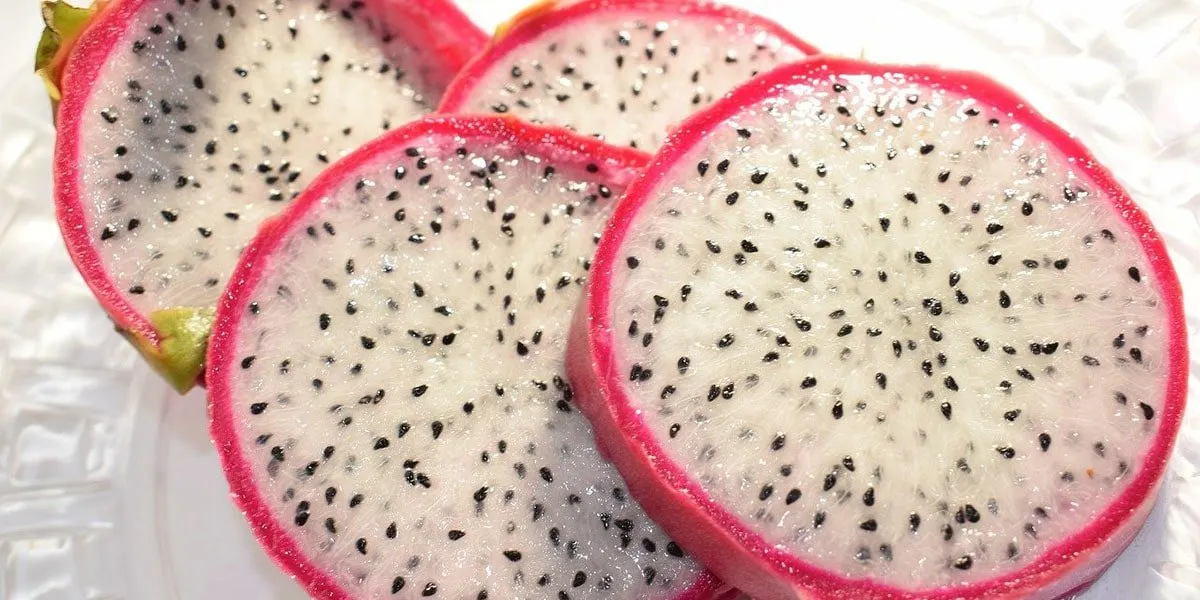A good amount of dragon fruit flesh consists of tiny black seeds. Just like the small seeds in a kiwi, these are perfectly edible, and might actually be good for you.
According to the World Journal of Pharmacy and Pharmaceutical Sciences, dragon fruit seeds contain a lot of healthy fatty acids such as Omega-3 and Omega-9. Among other benefits, these compounds are known to improve the cardiovascular system and help balance cholesterol levels.
So if you’re worried about consuming pitaya seeds, rest assured that this part of the fruit is perfectly fine to consume. Let’s explore what those weird black dots in dragon fruit have to offer!
Dragon Fruit Seeds Are Edible
It’s not strange to consider whether or not a dragon fruit seed is edible. There are plenty of fruit seeds that are poisonous, such as those from apples, cherries, apricots, plums, or peaches.
The common denominator is cyanide, a substance that naturally resides within the seeds of some popular fruits. Accidentally swallowing an apple seed or two won’t hurt you, but eating too many might literally poison you.
For the dragon fruit, there’s nothing to worry about. None of the popular dragon fruit varieties contain poisonous cyanide within the seeds, they are OK to eat. Even the big black seeds in the yellow pitaya (Selenicereus megalanthus) are safe to eat and are non-poisonous.

Does Your Body Digest Dragon Fruit Seeds?
The human body is incapable of digesting whole dragon fruit seeds, because they naturally have a protective gel coating. After consuming dragon fruit, your stool will still contain the majority of the small black seeds found in the pulp.
Chewed-up or broken dragon fruit seeds can be partially digested by the bacteria in the gut. These gut bacteria are able to extract the fatty acids from the seeds and transport them to other parts of the body.
After consuming a pitaya, don’t be scared if your stool is full of tiny black specks. It’s comparable to the body’s inability to digest whole corn kernels. These stand out a lot more in the toilet bowl thanks to the color contrast.
Should You Chew Dragon Fruit Seeds?
It is not necessary to specifically chew dragon fruit seeds to extract some of the nutritious fiber and fatty acids from them. Simply chew the juicy flesh of the dragon fruit and the seeds will be partially chewed in the process.
This is even true for the slightly bigger yellow dragon fruit mentioned before. While the texture might be a little more crunchy than a ‘regular’ variety, it won’t help to consciously chew on the seeds themselves. It won’t make the fruit any more healthy or easier to digest.
Potential Benefits Of Dragon Fruit Seeds
The parts of the dragon fruit seeds that can be digested will contain a lot of fatty acids and natural oils. Many of the substances found in them are known to have beneficial health effects.
That being said, the pulp of a pitaya will probably be healthier for you than the seeds. There is simply a lot more of it! But the potential benefits from the omega 3 and omega 9 fatty acids in dragon fruit seeds should not be ignored.
Unfortunately, we are not an authorized health authority and legally cannot make firm claims about the health impacts of foods. However, we can forward you some reading material on the subject that might help you inform yourself:
How Many Seeds Are In A Dragon Fruit?
On average, the common white dragon fruit will have between 1000 and 1500 small black seeds in the edible flesh. However, each individual dragon fruit will contain a different amount of seeds depending on its size.
Please note that this is only a rough estimation based on a partial cut-out count. The overall size of the fruit will ultimately determine how many seeds your fruit will contain.
It is possible to extract these seeds from the flesh to grow your own dragon fruit cactus (yes, it’s a cactus fruit!). You could even do it with store-bought fruit. The process consists of drying out thin slices and spreading the pulp on a paper towel. Find more instructions here.
Flesh, Seeds, Skin: You Can Eat It All
Interestingly enough, every part of this tropical delicacy can be consumed. The flesh is an obvious choice, and we just learned that the seeds are safe to eat. But did you know that the colorful skin of this fruit is also edible?
It might taste firm and rubbery when eating it raw, but it’s perfect after cooking it. Do make sure to properly wash the skin, as it might still contain trace amounts of pesticides. Warm water and a firm scrub with a brush will do the trick. Most people actually use it in skincare products, though.
If you want to try the tasty parts of dragon fruit, the flesh and seeds are the parts to focus on. Don’t be shy when chomping down on the insides, as long as you know it’s a perfectly ripe pitaya. That’s when the flavors and the eating experience will be the best.



